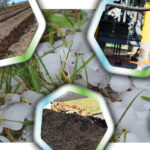
Nora Goldstein
BioCycle February 2016
An article headline in the February 6 edition of the New York Times, “Cover Crops, a Farming Revolution With Deep Roots in the Past,” caught my eye and I thought, why revolution? Here’s the opening paragraph: “When Mark Anson came home with his hair on fire after a seminar on the seemingly soporific topic of soil health, his younger brother, Doug, was skeptical. What had Mark lit up was cover crops: fields of noncash crops like hairy vetch and cereal rye that act on soil like a nourishing facial after the harvest.Mark, 60, and his two brothers, together with assorted sons and sons-in-law, run Anson Farms, a big commercial soybean and corn operation in Indiana and Illinois. Concern about the soil quality of the family’s fields had nagged at him for some time. ‘Our corn was wilting when temperatures hit 103 degrees,’ he said. …. What he learned about the benefits of cover crops gave him hope. But to Doug, planting some noncommercial crops seemed an antiquated practice, like using a horse-drawn plow.”
In 2010, the Ansons sowed what Mark described as “highly eroded farmland” with wheat cleanings and cereal rye, and also planted cover crops in eroded areas of several other fields. The next spring, the water that ran off the eroded land was clear, “a sign that the roots of the cover crops were anchoring valuable topsoil in place,” wrote Strom. But it took a terrible drought in 2013 for Doug to “become a believer.” That was when part of a field that had been planted with cover crops was getting 20 to 25 more bushels of corn per acre than places where no cover crops were planted. Today, 13,000 of the 20,000 acres farmed by the Ansons are planted with cover crops post harvest.
I share this anecdote because it is very symbolic of what is discovered when using compost to amend highly depleted soil. Water infiltrates soil amended with compost during storm events, significantly reducing erosion. This happens in part because the roots of the vegetation planted in compost-amended soil extend further into the soil layers, opening up pathways for the storm water. The cover crops provide nutrients. So does the compost. And so on.
The critical role that compost plays in building healthy soils will be a hot topic at BioCycle’s 30th Anniversary West Coast Conference, April 4-7, 2016 in San Diego, California (see pages 13-16 for details). It starts with a presentation on the role of compost and mulch in complying with California’s Water-Efficient Landscape Ordinance, and continues with a session on the California Department of Food & Agriculture’s (CDFA) Healthy Soils Initiative, which will likely incentivize use of compost in agriculture. A few weeks ago, while pulling together this session, I reviewed documents prepared for a January 2016 CDFA meeting on the Initiative, held in conjunction with CalRecycle. Included is an excellent research report, “Agronomic rates of compost application for California croplands and rangelands to support a CDFA Healthy Soils Incentives Program,” based on research conducted by Kelly Gravuer, a PhD candidate at the University of California, Davis.
The New York Times article also describes a farmer in Indiana who was repairing a drainage tile in a test field planted with cover crops and came across the deep, webbed root system that some Oregon ryegrass had put into the soil. “I thought to myself, I have been pulling the guts out of my tractor to remove compaction 14 inches deep with a ripper,” the farmer told Strom, “and this plant has just bored a system of micropores four feet deep between cash crops all on its own. …. That was the aha moment.”
Now back to my original question — why are cover crops a “revolution?” Cover crops, like compost, are time-proven tools. Let’s teach these new dogs our old tricks.









